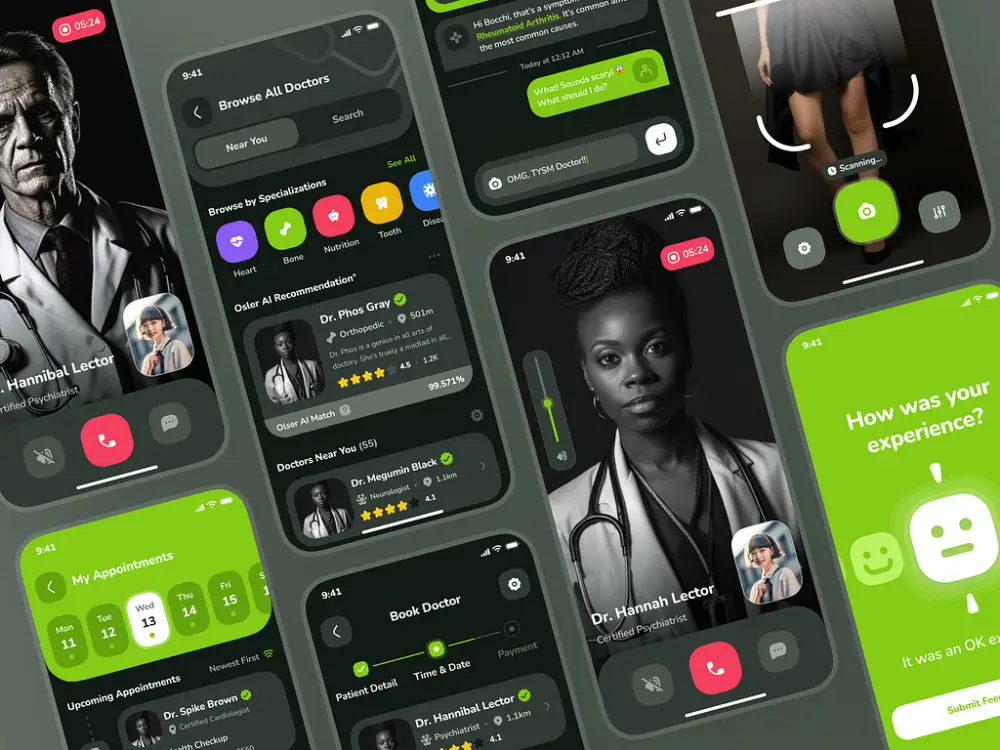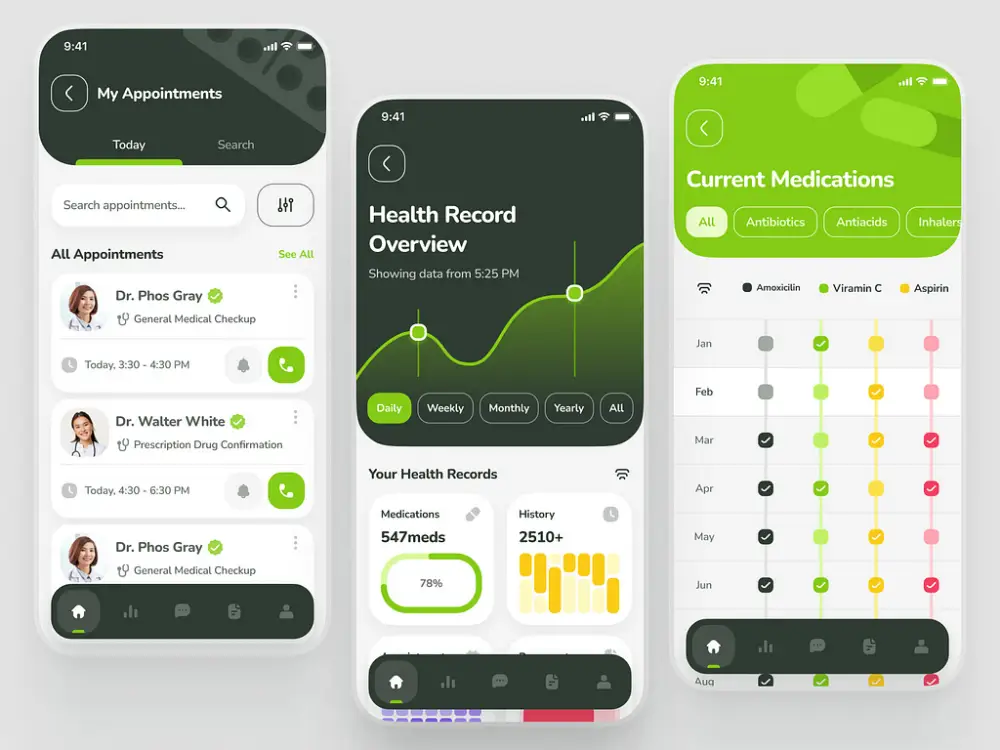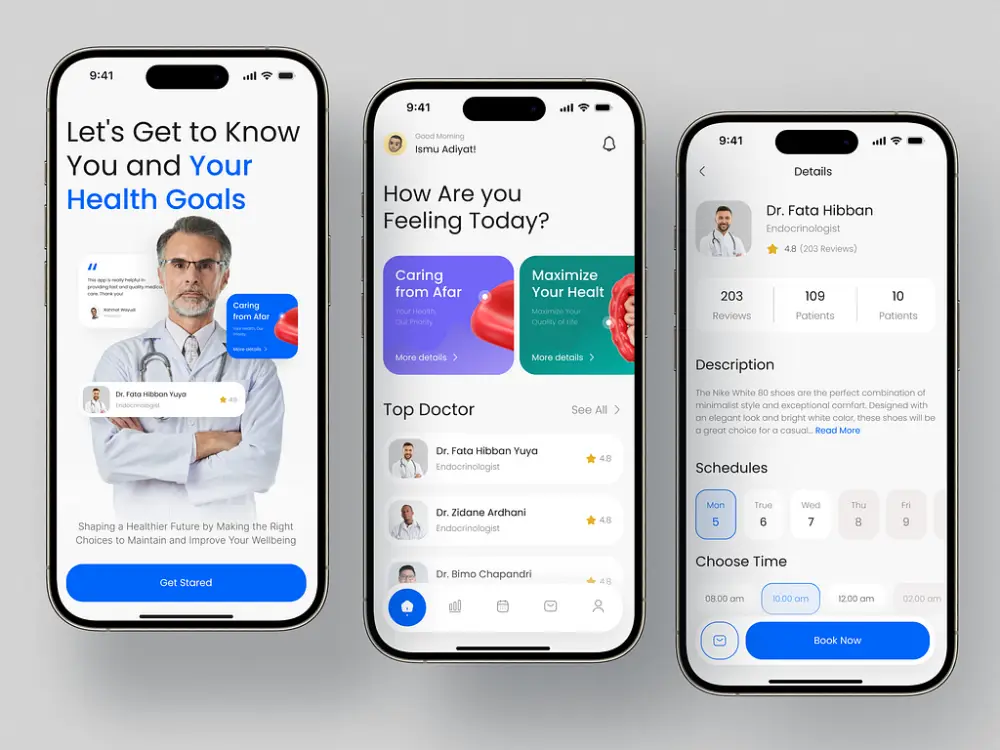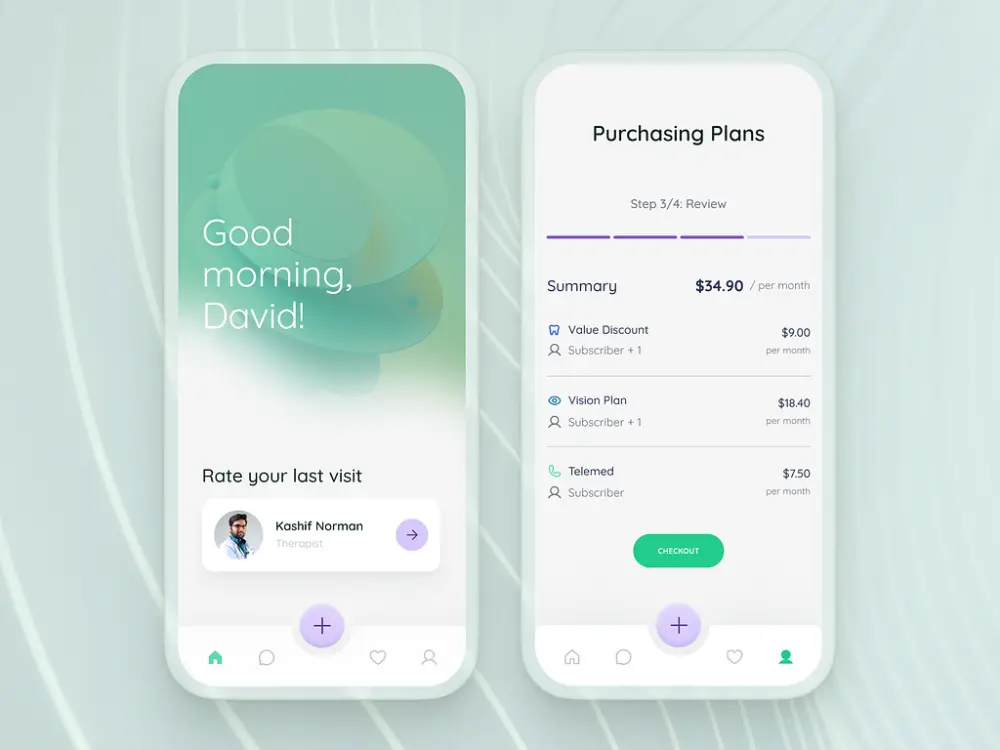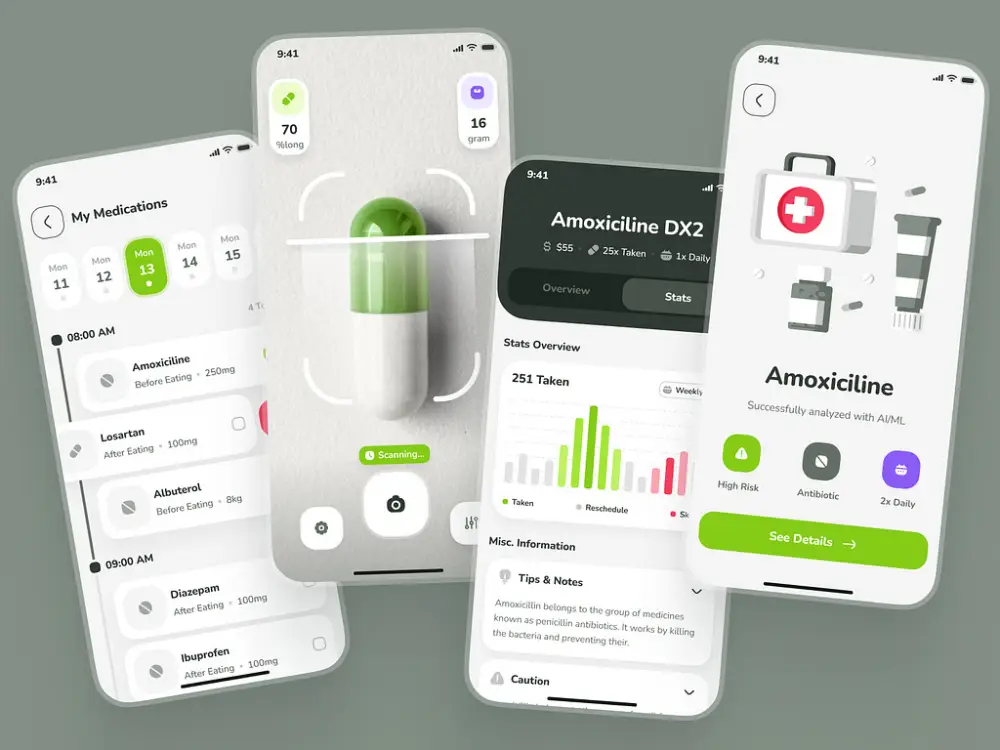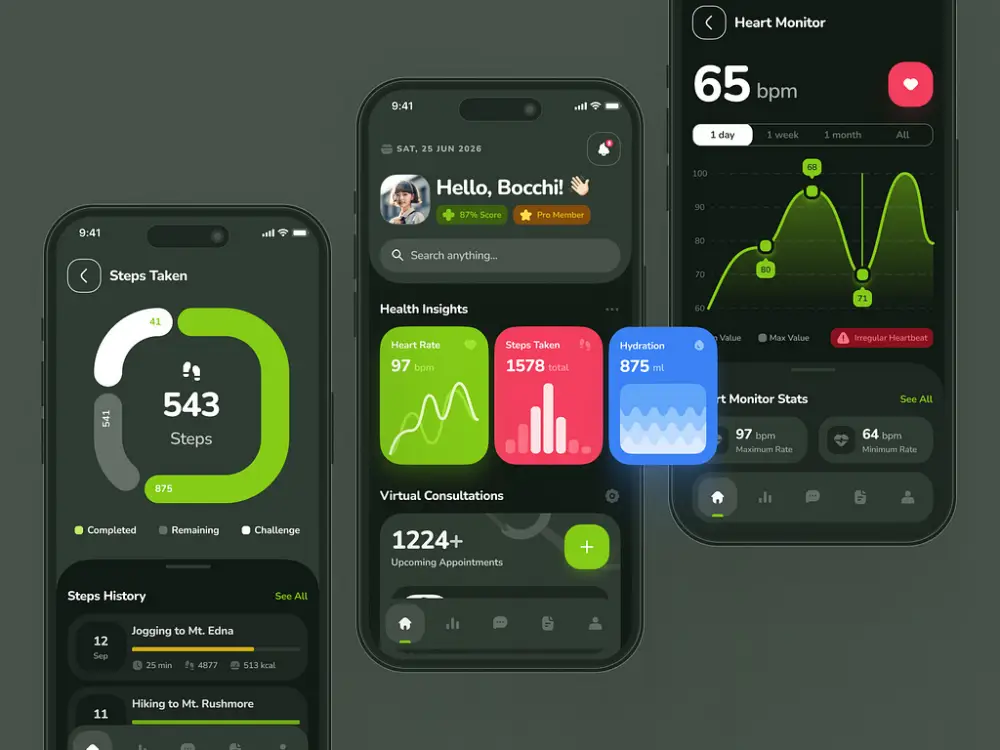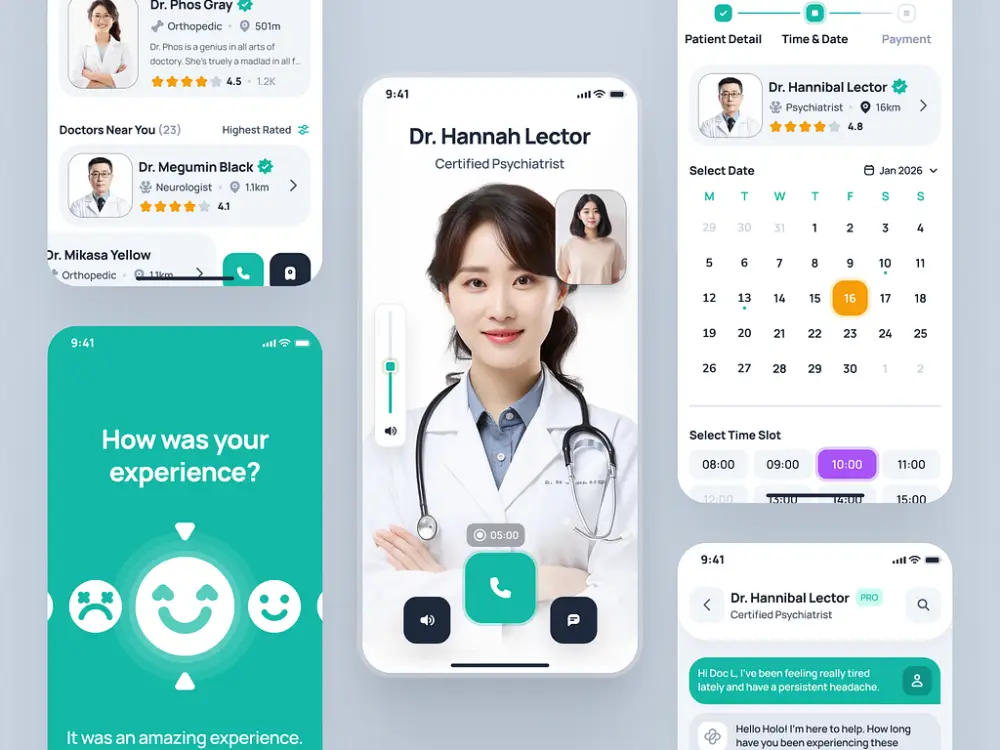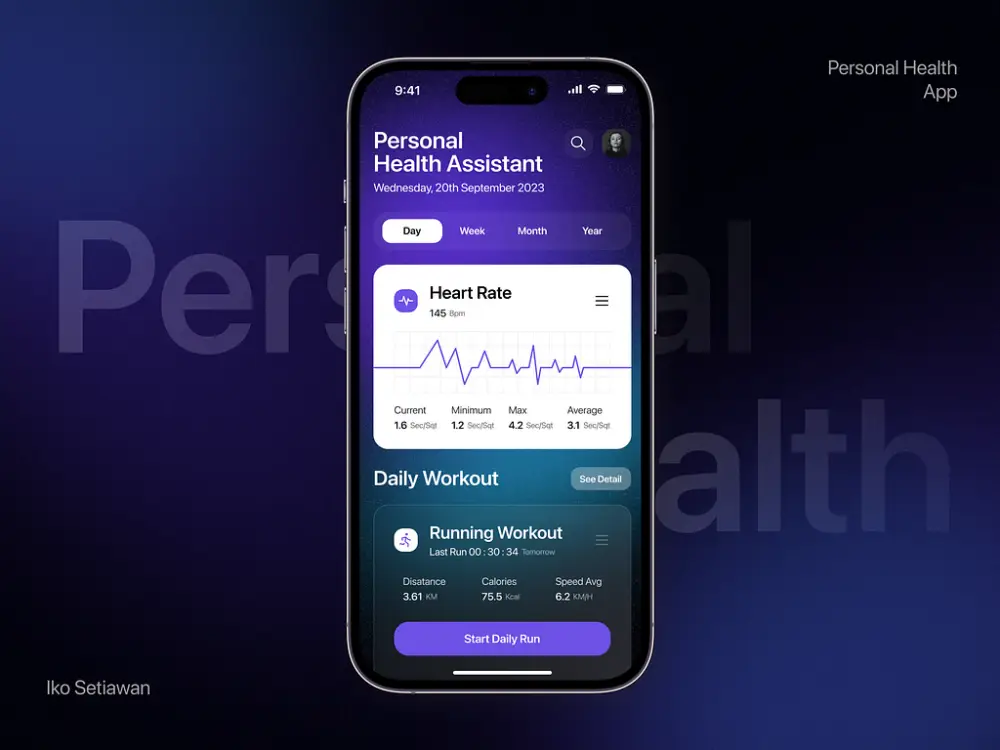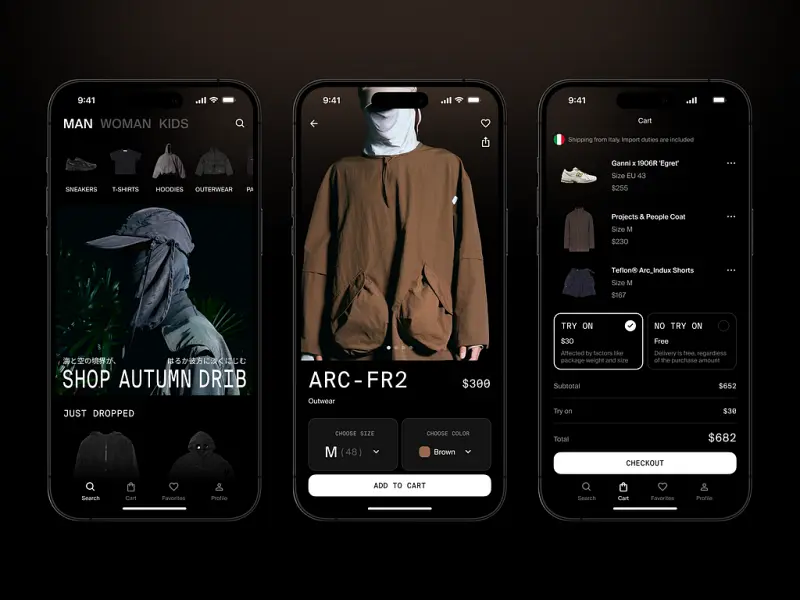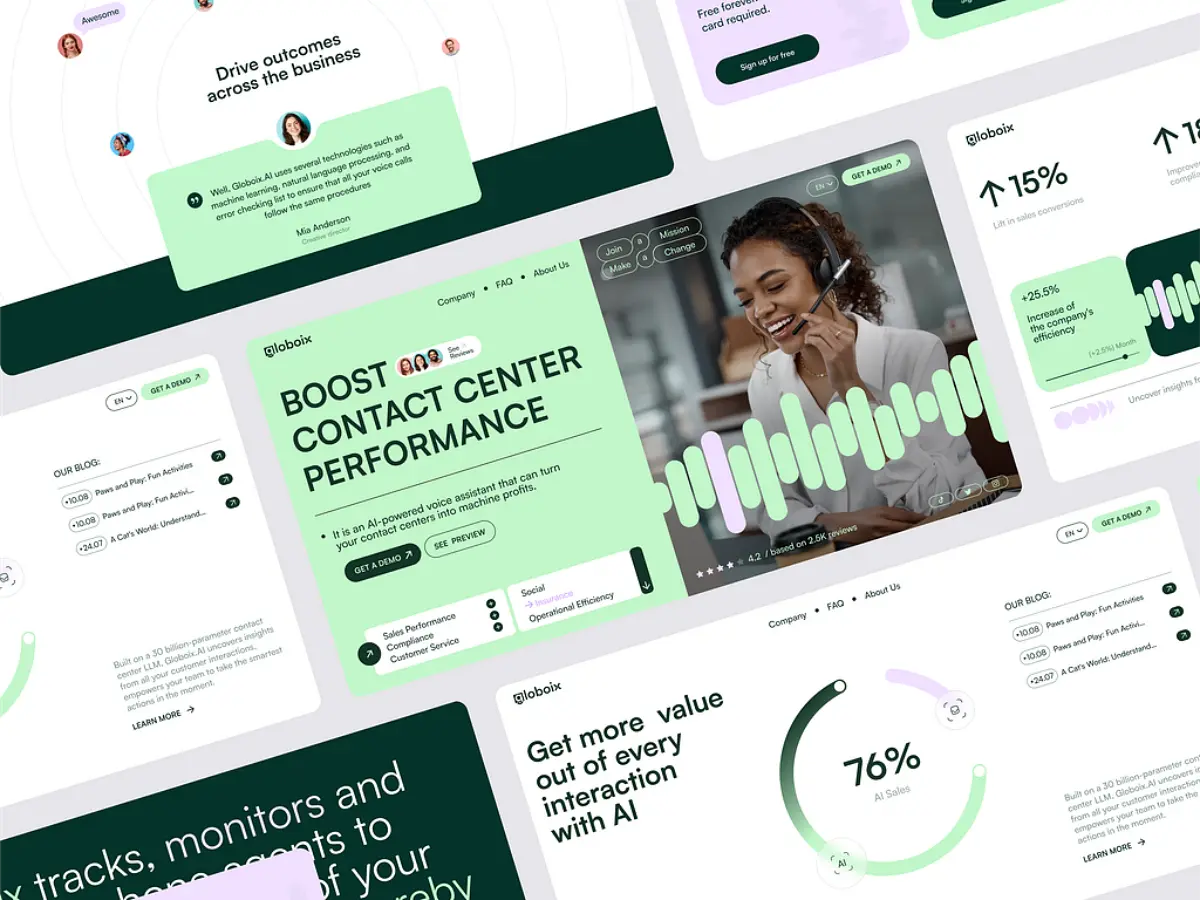Telemedicine App Development In 2025: Features, Trends & Monetization
- TECHVIFY Team
- 0 Comments
Telemedicine app development is on the rise. The need for digital health solutions has never been more evident, and now is the perfect time to dive into this exciting field. Whether you’re a tech enthusiast, a healthcare professional, or an entrepreneur with a vision, creating a telemedicine app can be your ticket to making a significant impact.
Despite economic uncertainties, the digital health sector continues to attract attention and investment. Innovators like you are at the forefront, ready to harness the power of AI, IoT, and data analytics to revolutionize healthcare. The key to success? Innovation and a clear roadmap.
In this guide, we’ll walk you through every step of the telemedicine app development journey – from conceptualizing your idea to launching your product. Let’s get started on turning your vision into a reality!
1. What Is Telemedicine App?
Imagine a world where you can check your health from the comfort of your home, measuring your blood pressure and heart rate, and then instantly sending the data to your doctor. With a few taps on your phone, your doctor can assess your condition, prescribe medications, and determine if you need further tests at the hospital. This isn’t science fiction – it’s the promise of telemedicine apps, and healthcare startups are racing to make it a reality.
So, what is a telemedicine app? A telemedicine app is a digital platform that enables remote healthcare services through online communication and data exchange between patients and healthcare providers. It leverages technology to deliver medical consultations, treatments, and monitoring without the need for in-person visits.
The core idea behind telemedicine is to enhance traditional healthcare with advanced technology, making medical services accessible and affordable for everyone, everywhere. Here’s a glimpse of the major healthcare services that telemedicine app development brings to the table:
- Online Chat Messaging & Video Calls With Doctors: Connect with healthcare professionals in real-time, no matter where you are.
- Assess and Treat Minor Health Conditions: Get quick evaluations and treatments for non-emergency medical issues.
- Access Therapy and Other Mental Health Services: Find support and therapy sessions conveniently through your device.
- Request or Renew Prescriptions for Medications: Easily manage your medication needs without the hassle of in-person visits.
- Monitor Physical Health Conditions: Keep track of chronic conditions with regular remote monitoring and updates.
Telemedicine apps are designed to bridge the gap between patients and healthcare providers, offering a seamless, technology-driven approach to modern healthcare.
Looking to Develop a Telemedicine App?
TECHVIFY is your perfect partner. Book a free consultation to receive a precise time and cost estimation for your telemedicine app project.
2. Essential Types of Telemedicine Apps to Consider
As the field of telemedicine app development continues to evolve, it’s important to understand the various types of telemedicine apps that are making significant impacts in healthcare. Here are the key categories you should consider:
2.1. Digital Therapy
Digital therapy apps are transforming the landscape of therapeutic care by providing access to evidence-based interventions directly through your device. These telemedicine apps leverage AI and machine learning to offer personalized treatment for various conditions, making therapy more accessible than ever.
With the digital therapeutics market poised to reach $13.1 billion by 2026, the impact of this innovation is substantial. Companies like Neuroglee Therapeutics and Biofourmis are at the forefront, offering state-of-the-art solutions that enhance patient care.
2.2. Remote Monitoring
Remote monitoring apps provide continuous health oversight, enabling proactive and personalized care. These telemedicine apps are essential for managing chronic conditions, post-operative recovery, and elderly care by tracking vital signs and health metrics in real-time.
The global remote patient monitoring market is anticipated to reach $3.24 billion by 2027, reflecting its growing importance. Market leaders like eVisit, MedM, and Teladoc are pioneering this space, offering innovative solutions that ensure timely medical interventions.
2.3. Chronic Conditions Treatment
Telemedicine apps specialized in chronic conditions treatment provide essential support for long-term health management. These apps facilitate regular monitoring, medication management, and virtual consultations, empowering patients to manage their health effectively.
With the usage of mHealth apps for chronic conditions reaching 59.8% in 2019, their significance is undeniable. Companies like Curable, Livongo, and Hello Heart are pioneering this field, offering comprehensive tools to enhance patient well-being.
Learn More On:
3. Why You Should Go for Telemedicine App Development
In today’s tech-driven world, telemedicine app development is revolutionizing healthcare by making medical consultations, diagnostics, and treatments accessible from anywhere. Leveraging cutting-edge technologies like AI, AR, and GenAI, these apps offer unprecedented ease and efficiency. Imagine a future where healthcare is at your fingertips – this is the promise of telemedicine apps. Let’s explore why investing in this innovative field is essential for forward-thinking healthcare providers and tech innovators.
3.1. Key Market Insights of Telemedicine App Development
The telemedicine market has experienced remarkable growth recently, driven by technological advancements and global health crises. Here are some key market insights that highlight the potential and trajectory of telemedicine app development:
The telemedicine market size was valued at USD 87.41 billion in 2022 and is projected to grow to USD 94.44 billion in 2023, reaching USD 286.22 billion by 2030. This represents a compound annual growth rate (CAGR) of 17.2% during the period from 2023 to 2030. North America led the global market, holding a significant share of 47.87% in 2022.
- Impact of COVID-19: The sudden onset of the COVID-19 pandemic significantly boosted the use of digital health solutions. As hospitals faced increased admissions of COVID-19-positive patients, the healthcare sector experienced tremendous strain. The postponement and cancellation of elective surgeries and appointments led to decreased patient volume in traditional settings, creating an urgent need for telehealth solutions to maintain patient-physician connections.
- Surge in Demand: Social distancing norms during the pandemic heightened the demand for teleconsultations and digital health services. Virtual visit service providers saw a substantial increase in users. For instance, Teladoc Health Inc. reported a 60% rise in virtual consultations, reaching 2 million from January to March 2020 compared to the previous quarter.
- Rising Healthcare Costs: The increasing prevalence of chronic diseases and out-of-pocket healthcare expenditures have driven up healthcare costs. In the U.S., national healthcare spending reached USD 4.3 trillion in 2021, a 2.7% increase from 2020, with per person spending at USD 12,914. Additionally, Eurostat reported that in 2017, healthcare costs were a financial burden for 34% of the population, with 11% considering them a heavy financial burden.
- Economic Benefits: The adoption of teleconsultations and digital health technologies provides cost-effective healthcare solutions and reduces the workload on healthcare professionals. During the COVID-19 pandemic, telehealth saved an estimated USD 33.5 million in travel-related costs, according to UC Regents in January 2023. This economic benefit has led government organizations to emphasize the deployment of digital health technologies, further driving the growth of the telemedicine market.
3.2. The Power of Real-World Data in Telemedicine
Imagine a world where every heartbeat, step, and sleep pattern can be seamlessly captured and analyzed to improve health outcomes. This is not a distant future but the reality we are stepping into with telemedicine app development. Telemedicine and devices like smartphones, wearables, and sensors are becoming inseparable companions in our healthcare journey.
For instance, wearable devices can monitor heart rates, track sleep patterns, and even remind users to stay hydrated. All this data is collected and sent to telemedicine apps, providing healthcare providers with invaluable real-world insights. This continuous stream of information helps doctors make more informed decisions, tailoring treatments to individual needs.
While some might argue that we are becoming increasingly dependent on these devices, the truth is that they offer priceless data to medical organizations. This real-world data is a treasure trove of information, unlocking answers and insights that can lead to better clinical treatments. Companies that skillfully integrate and analyze this health data from telemedicine apps are not just enhancing patient care – they are paving the way for a new era of personalized medicine.
The value lies in this data. As more health-related information is collected and analyzed, the potential for improved treatment outcomes grows exponentially. Organizations that harness this power stand to revolutionize healthcare, turning real-world data into real-world solutions.
Learn More On:
3.3. The Rise of Personalized Healthcare
Healthcare is undergoing a profound transformation, becoming more personalized than ever before. Telemedicine offers a unique opportunity to reinvent the healthcare industry completely. With technological advancements like virtual treatment, remote health monitoring, and smart algorithms, the healthcare system is now centered around the patient experience, ensuring the best possible care.
Envision a future where healthcare startups develop effective drug therapies tailored to individual conditions. These therapies would be safer, cheaper, and more efficient because they are fine-tuned to each person’s unique genetic makeup. This level of personalization is no longer a distant dream but an emerging reality, thanks to the integration of advanced technologies in telemedicine.
Telemedicine apps and platforms are at the forefront of this revolution, enabling healthcare providers to deliver customized treatment plans based on real-time data and sophisticated algorithms. This approach not only enhances patient outcomes but also optimizes resource utilization, making healthcare more accessible and affordable.
In this evolving landscape, treatments are becoming as unique as the individuals receiving them. As personalized healthcare continues to grow, the potential for improved health outcomes and patient satisfaction becomes limitless.
3.4. The Evolution of Remote Lifestyles in Healthcare
The COVID-19 pandemic significantly accelerated the shift to online consultations, making telemedicine a vital component of modern healthcare. Telemedicine apps enable users to send short messages, share photos or documents with doctors, and receive immediate consultations. Once people experience this convenience, they are unlikely to revert to traditional methods.
The trend toward a remote lifestyle is evident across various sectors, and healthcare is no exception. Telemedicine has the potential to become a cornerstone of universal health coverage by providing cost-effective and accessible care. As remote work and virtual interactions become the norm, telemedicine aligns perfectly with this lifestyle, offering seamless integration of healthcare into daily life.
Telemedicine apps allow for continuous patient-doctor communication, ensuring timely medical advice and intervention. This remote access to healthcare services not only enhances patient convenience but also reduces the burden on healthcare facilities, streamlining operations and improving efficiency.
Adapting to this remote lifestyle trend is reshaping healthcare delivery, making telemedicine an indispensable tool for modern healthcare. By embracing this shift, healthcare providers can offer more flexible, responsive, and patient-centered care, meeting the evolving needs of today’s society.
Let’s Talk About Your Telemedicine App
A consultation with the Client Relationship Manager from TECHVIFY, focused on telemedicine app development, will provide you with:
- A structured and clear vision for your telemedicine application
- Insights into how our software development company ensures 100% on-time and on-budget delivery
- Expert recommendations for selecting the most suitable tech stack
- Guidance on next steps in your development journey
- Business-side strategies tailored to the healthcare sector
- A rough project estimation for your telemedicine app development
TECHVIFY is precisely where you need us. Reach out now for a consultation:
4. Monetization Strategies for Telemedicine Apps
Monetizing telemedicine apps is crucial for sustainability and growth. There are several effective strategies that can be employed to generate revenue while ensuring the app remains valuable to users. Here are some effective monetization methods:
4.1. Subscription Model
The subscription model is a popular approach where users pay a recurring fee to access the app’s features and services. This model ensures a steady income stream and encourages long-term user engagement.
- Monthly/Yearly Fees: Users pay a monthly or yearly fee to use the app, providing them with continuous access to telemedicine services.
- Tiered Plans: Different subscription tiers offer varying levels of service, such as basic consultations, premium health monitoring, and personalized care plans.
- Family Plans: Offer subscription packages for families, allowing multiple users to access the app under a single account.
4.2. Transaction Fees
In the transaction fee model, the platform charges a fee for each payment a user makes. This method is effective for apps that facilitate individual transactions between patients and healthcare providers.
- Consultation Fees: The app takes a percentage of the fee for each medical consultation conducted through the platform.
- Prescription Orders: Users pay a transaction fee for ordering prescriptions or other medical supplies via the app.
- Appointment Bookings: Charge a fee for booking appointments with specialists or for accessing premium medical services.
4.3. In-App Advertising
In-app advertising allows telemedicine apps to earn revenue by displaying ads within the app. This model works well if the app has a large user base and high engagement rates.
- Banner Ads: Display banner ads at the top or bottom of the app interface, ensuring they are visible but not intrusive.
- Video Ads: Integrate short video ads that users can watch in exchange for additional features or credits within the app.
- Sponsored Content: Collaborate with healthcare brands to feature sponsored articles, tips, or product recommendations within the app.
4.4. Additional Monetization Strategies
Beyond the primary models, there are other innovative ways to monetize telemedicine apps that can complement the main revenue streams.
- Freemium Model: Offer a basic version of the app for free while charging for advanced features and services.
- Partnerships: Partner with insurance companies, pharmacies, and healthcare providers to offer integrated services and share revenue.
- Data Analytics Services: Provide anonymized health data analytics to research organizations and healthcare companies for a fee, ensuring privacy and compliance with regulations.
By blending these monetization strategies, telemedicine apps can not only achieve financial sustainability but also enhance their value proposition. Tailoring these approaches to the unique goals and user base of each app can create a dynamic and robust revenue model. This, in turn, supports the continuous delivery of innovative and high-quality healthcare services, making a lasting impact on patient care and well-being.
Learn More On:
5. Must-Have Features for Telemedicine Apps
Telemedicine apps are as diverse as the healthcare services they offer, from mental health support to virtual medical treatments. The features required for patients and doctors also vary, catering to their specific needs and workflows. Leveraging the extensive expertise of domain and industry professionals at TECHVIFY, we’ve identified the essential features that every telemedicine app should include.
Moreover, the integration of AI is revolutionizing telemedicine, enhancing app capabilities to provide more personalized, efficient, and proactive healthcare solutions. Here’s a closer look at the must-have features for both patients and doctors, shaped by the latest advancements in AI technology.
5.1. Essential Features for Patients
Imagine being able to manage your healthcare needs right from the palm of your hand. Telemedicine apps bring this vision to life, making healthcare more accessible and convenient than ever before. Here are the must-have features that transform a simple app into a comprehensive health companion for patients:
- Patient Profile: Create a detailed profile that includes personal health information, medical history, and ongoing treatments, ensuring personalized care tailored to your unique needs.
- Search for Doctors: Easily find and connect with the best doctors based on specialty, location, availability, and patient reviews, all within a few taps.
- Appointment Booking: Seamlessly schedule appointments with your preferred healthcare providers, eliminating the hassle of phone calls and waiting times.
- In-App Chats with Doctors: Engage in real-time text conversations with your doctors, getting quick answers to your health queries without the need for an in-person visit.
- In-App Video Calls with Doctors: Experience face-to-face consultations through high-quality video calls, bringing the doctor’s office to your home for a more personal connection.
- Payments: Securely handle payments for consultations and treatments directly through the app, simplifying the financial aspect of your healthcare journey.
- Notifications/Reminders: Receive timely reminders for upcoming appointments, medication schedules, and follow-up tasks, helping you stay on top of your health.
- Ratings and Feedback: Share your experiences and read reviews from other patients to make informed decisions about your healthcare providers and services.
These features are designed to empower patients, providing them with the tools they need to take control of their health in a convenient, efficient, and secure manner.
5.2. Essential Features for Doctors
For healthcare professionals, telemedicine apps aren’t just about convenience—they’re about transforming the way they deliver care. By integrating cutting-edge features, these apps help doctors manage their practice more efficiently and provide better care for their patients. Here’s a look at the must-have features for doctors:
- Doctor Profile: Build a comprehensive profile showcasing your expertise, specialties, and experience, helping patients find the right doctor for their needs.
- Schedule Management: Effortlessly manage your daily schedule, coordinate appointments, and ensure there are no overlaps, keeping your practice running smoothly.
- Appointment Management: Streamline the process of handling appointments, from booking to reminders, ensuring you and your patients are always in sync.
- 1:1 and Group In-App Chats: Communicate directly with patients or collaborate with other healthcare professionals through secure text chats, enhancing the continuity of care.
- 1:1 and Group In-App Video Calls: Conduct virtual consultations with patients or hold meetings with colleagues via high-quality video calls, breaking down geographical barriers.
- Electronic Medical Records: Access and update patient records digitally, ensuring you have all the necessary information at your fingertips while maintaining confidentiality.
- Prescriptions: Generate and send electronic prescriptions quickly and accurately, simplifying the process for both you and your patients.
These features are designed to support doctors in providing high-quality, efficient, and patient-centered care, leveraging technology to overcome traditional barriers in healthcare delivery.
Inspired to Create a Telemedicine App?
Connect with our experts for a complimentary consultation. We’ll guide you through the next steps, demystify the development process, and provide you with a free project estimate. Let’s turn your vision into reality!
6. Telemedicine App Development Cost
The cost of developing a telemedicine app largely hinges on the features you wish to include and the outsourcing vendor you select. Here’s a detailed look at what to expect in terms of expenses and considerations.
If you aim to build a comprehensive telemedicine platform with essential features such as online video consultation, appointment scheduler, backend management, and a custom interface, the development cost will start from approximately $20K to $24K, assuming an hourly rate of $25 to $30. This estimate encompasses the entire development process, post-release support, product management, and team communication.
However, the price can escalate based on the complexity and number of features, potentially reaching $40K to $50K.
Choosing a reliable telemedicine app development company from Vietnam can be a cost-effective and quality-assured option compared to vendors from the USA or Europe. Vietnamese development firms are known for their high-quality services and competitive pricing, making them an excellent choice for your telemedicine project. This approach ensures you get a robust and efficient product without compromising on quality.
| Features | ~ Development Time (hrs) | ~ Cost ($25/hr) | ~ Cost ($30/hr) |
|---|---|---|---|
| Appointment Scheduler | 80 | $2,000 | $2,400 |
| Online Video Consultation | 120 | $3,000 | $3,600 |
| Backend Management | 80 | $2,000 | $2,400 |
| Custom Interface | 90 | $2,250 | $2,700 |
| In-App Chats | 120 | $3,000 | $3,600 |
| Patient & Doctor Profile | 90 | $2,250 | $2,700 |
| Electronic Medical Records | 80 | $2,000 | $2,400 |
| Notifications/Reminders | 60 | $1,500 | $1,800 |
| Payments | 80 | $2,000 | $2,400 |
| Ratings and Feedback | 20 | $500 | $600 |
Learn More On:
7. How To Develop A Telemedicine App: End-to-End Development
Embarking on the journey of telemedicine app development can be both exciting and daunting. At TECHVIFY, we transform this intricate process into a structured and manageable adventure by breaking it down into four essential phases. Our meticulous approach ensures that every aspect, from initial concept to post-launch support, is handled with precision and care. Here’s how we do it:
- Discovery
- Design
- Development
- Post-Launch
Join us as we explore each phase in detail, unveiling the secrets to creating a successful telemedicine app.
7.1. Discovery
The Discovery phase is where the magic begins. At TECHVIFY, we immerse ourselves in your vision to truly understand the essence of your project. This stage is all about a deep dive into the nitty-gritty details: understanding the problem statement, crafting the vision, defining the scope, and analyzing market trends. Here’s what our Discovery process typically involves:
- Market & Competitor Research: We meticulously study the market landscape and analyze competitors to uncover opportunities and challenges.
- User Research: We delve into the needs and behaviors of potential users to ensure the app meets their expectations.
- Creating Proto Personas: We develop preliminary user personas to guide our design and development efforts.
- Prototyping and Testing Hypotheses: We create prototypes and test various hypotheses to validate our ideas.
- Validating Tech Feasibility: We assess the technical feasibility of the proposed solutions to ensure they are viable.
Our aim is to craft a user-friendly product that precisely fits the market needs. It’s crucial to clearly define the problem your product will address. Whether it’s enhancing patient care, increasing patient satisfaction, streamlining healthcare provider workflows, or reducing patient no-shows, the problem statement is our guiding star. Based on this, we identify the target audience, outline the feature set, and brainstorm the best technological solutions. This meticulous approach ensures that the final product not only meets but exceeds expectations.
7.2. Design
With the insights and data gathered during the Discovery phase, we transition into the creative and strategic realm of Design. This phase is where we transform ideas and concepts into tangible, user-centered designs. The design process for a telemedicine app follows a structured approach similar to other product designs and includes the following key components:
- Wireframes: We create a skeletal outline of the future product, serving as a blueprint for the app’s structure and functionality.
- User Flow: We visualize the elements of the app and map out the connections between the steps users will take, ensuring a seamless navigation experience.
- UX & UI Design: We craft the final product design, focusing on an interface that is both aesthetically pleasing and user-friendly.
Telemedicine apps, like any healthcare product, require an elevated level of user experience due to the diverse needs of users, who may have varying mental or physical conditions. It’s vital to provide an intuitive user experience and adhere to the latest accessibility design trends. By doing so, we ensure that your app is not only functional but also inclusive and easy to use for all potential users.
7.3. Development
As we move into the Development phase, this is where the magic happens. It’s time to bring our knowledge and design concepts to life, shaping them into a fully functional product. Developing telemedicine software is a complex task that requires careful attention to various critical elements, including:
- HIPAA Compliance: Ensuring the app meets all necessary regulations to protect patient information.
- UX-Friendly Interface: Creating an interface that is easy to navigate and use.
- Video and Audio Connection Quality: Providing high-quality, reliable video and audio connections.
- Good Support: Offering robust support to address any user issues.
- Video Recording Capability: Including the ability to record video sessions securely.
- Secure Information Handling: Protecting users’ data through rigorous security measures.
- Transparent Rating System: Implementing a clear and fair rating system for users and providers.
Implementing these functionalities takes time and expertise. Here are some tips from my working practice that can streamline the development process:
- Use Compliant 3rd Party Providers: Leveraging third-party services can save time and resources.
- Choose the Right Tech Stack: Selecting the appropriate technologies ensures scalability and reduces risks.
- Hire Experienced Telemedicine App Developers: Skilled developers with telemedicine experience are crucial for a successful project.
HIPAA Compliance Checklist
Using third-party providers can expedite development, and there are excellent solutions available for telemedicine apps. Refer to the HIPAA Compliance checklist for more details. From a product perspective, ensure:
- Data encryption
- Safe and secure backup
- Secure authentication process
- Automatic log out
Telemedicine App Development Tech Stack
Choosing the right tech stack is essential for scalability and risk mitigation. Here’s a recommended tech stack for telemedicine app development:
- Mobile Development: Kotlin, Java (Android), Swift (iOS)
- Back-End Development: Node.js, Ruby on Rails, Elixir
- Videoconferencing: RTMP, Twilio, WebRTC
- Chat: Twilio, Socket.io
- Database: MySQL
- APIs and Frameworks: Stripe, EC2, S3
- Security and Privacy: Firewall, Multi-Factor Authentication (MFA), AES-256 encryption
By following these guidelines and utilizing the right technologies, we ensure that your telemedicine app is robust, secure, and user-friendly, meeting all the necessary standards and delivering an exceptional user experience.
7.4. Post-Launch
It’s a common misconception that the product launch marks the end of the journey. In reality, it’s just the beginning. Post-launch, the adventure continues with user feedback, iterative improvements, and the development of subsequent versions.
At TECHVIFY, we thrive on this stage because it’s our chance to refine the product and watch it grow, making a tangible difference in people’s lives. Our commitment is to create meaningful products, and it’s only after the launch that we can truly assess whether we’ve hit the mark. Here’s what the Post-Launch phase entails:
- User Feedback: Collecting and analyzing feedback from real users to understand their experiences and identify areas for improvement.
- Iterative Improvements: Continuously updating the app based on user feedback and emerging trends to enhance functionality and user satisfaction.
- Next Versions: Planning and developing new versions of the app with additional features and improvements to keep it relevant and competitive.
We embrace this ongoing process of growth and enhancement, ensuring that the product not only meets but exceeds user expectations over time. This phase is crucial for the long-term success and impact of the telemedicine app, and we are dedicated to seeing it through.
TECHVIFY – Global AI & Software Solution Company
From Startups to Industry Leaders: TECHVIFY prioritizes results, not just deliverables. Accelerate your time to market and see ROI early with high-performing teams, AI (including GenAI) Software Solutions, and ODC (Offshore Development Center) services.
- Email: [email protected]
- Phone: (+84)24.77762.666




